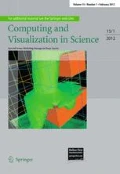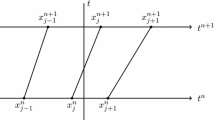Abstract.
The adaptive Rothe method approaches a time-dependent PDE as an ODE in function space. This ODE is solved virtually using an adaptive state-of-the-art integrator. The actual realization of each time-step requires the numerical solution of an elliptic boundary value problem, thus perturbing the virtual function space method. The admissible size of that perturbation can be computed a priori and is prescribed as a tolerance to an adaptive multilevel finite element code, which provides each time-step with an individually adapted spatial mesh. In this way, the method avoids the well-known difficulties of the method of lines in higher space dimensions. During the last few years the adaptive Rothe method has been applied successfully to various problems with infinite speed of propagation of information. The present study concerns the adaptive Rothe method for hyperbolic equations in the model situation of the wave equation. All steps of the construction are given in detail and a numerical example (diffraction at a corner) is provided for the 2D wave equation. This example clearly indicates that the adaptive Rothe method is appropriate for problems which can generally benefit from mesh adaptation. This should be even more pronounced in the 3D case because of the strong Huygens' principle.
Similar content being viewed by others
Author information
Authors and Affiliations
Additional information
Accepted: 12 August 1997
Rights and permissions
About this article
Cite this article
Schemann, M., Bornemann, F. An adaptive Rothe method for the wave equation. Comput Visual Sci 1, 137–144 (1998). https://doi.org/10.1007/s007910050013
Issue Date:
DOI: https://doi.org/10.1007/s007910050013




